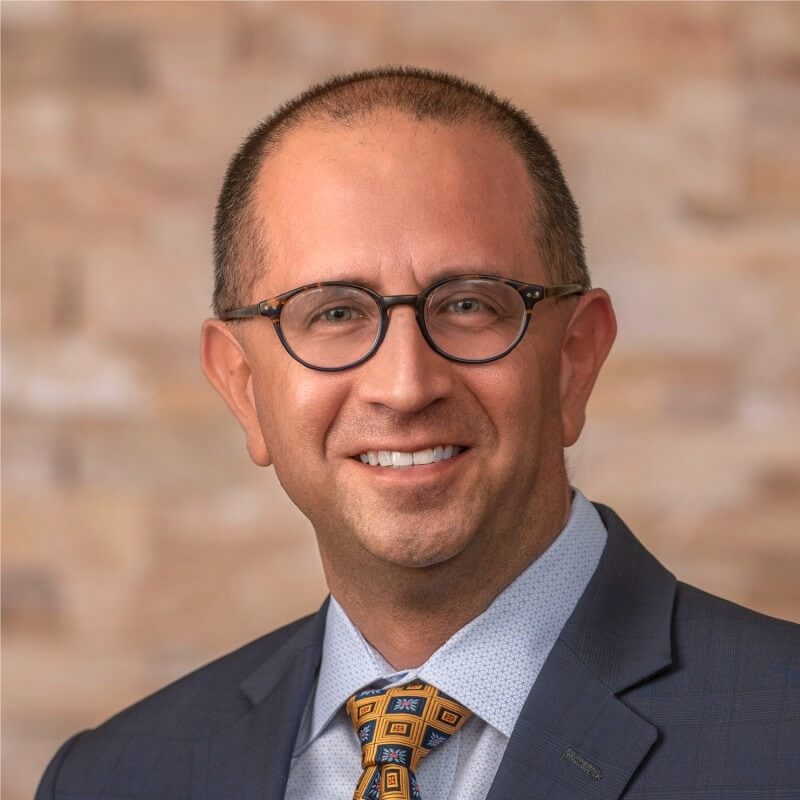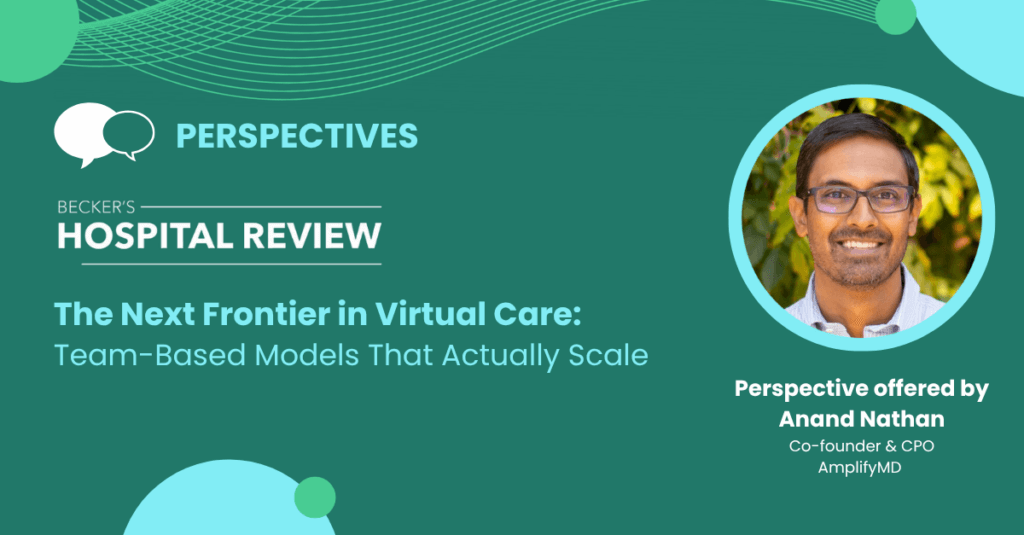AmplifyMD’s CEO, Meena Mallipeddi, regularly speaks with innovative healthcare leaders on her podcast, The Seamless Connection. This Q&A comes from her conversation with Dr. Doug Salvador, Chief Quality Officer at Baystate Health. (The podcast conversation has been edited and condensed.)

Doug Salvador, MD, MPH
Chief Quality Officer
Baystate Health
Dr. Salvador, what drew you to healthcare?
I’m a first-generation American: my dad was a concrete construction worker from Portugal, and my mom stayed home with my sister and me. We were raised on Long Island and were the first generation to go to college. So I didn’t have role models in healthcare, but as a typical immigrant story, my family really pushed higher education. I ended up going to college thinking I was going to be on a Ph.D. engineering track, but I felt at some point along the way that was a lot of delayed gratification, and I wanted more instant gratification. Being at Johns Hopkins, surrounded by some of the best diagnosticians and infectious disease doctors there were, it was easy to get enamored with medicine and medical school, so I chose that route instead.
When did your passion for quality and safety get started?
Twenty years ago, the healthcare quality and safety field was still relatively new, and as it pertained to diagnosis, which is really my passion, it was nascent. We had high hopes back then, and we all felt like there was momentum building. In my Infectious Disease Fellowship, I had started down a clinical trials and clinical research pathway, enrolling patients for four years, analyzing data for two, and hopefully getting a great answer. But during my Master’s in Public Health, I really discovered the immediate impact a focus on quality can make. I saw it as a way to use the scientific process (creating hypotheses, measuring and analyzing test results, and testing and refining our takeaways) as a way to make care better now, and I haven’t looked back. I’ve been a physician leader of quality and patient safety for the last approximately 20 years, and I’m not bored yet.
How much have things changed in the field since you got started?
I thought we’d be much farther along at this point than we are. There is a lot of evidence to point to, but the most recent New England Journal of Medicine study puts our healthcare system in a similar place to where we were even 30 years ago in terms of medical error and harm to patients. And so, frankly, I think all of us in the healthcare quality space are all a little disappointed.
What do you think is holding back the change that’s needed?
The foundation of everything in healthcare is the system. Like most folks who grew up in the quality movement, my major concerns span diagnosis, medication, or communication errors. What we need to improve those is a more integrated, more seamless, more reliable way to deliver to patients the little things they need every day in every clinic, on every shift, in any hospital. That high-reliability ideal is a lot about creating this complex socio-technical system that just works better than what we have today. The resulting improvements in quality and safety are what we get.
But when we talk about root causes and problems in a healthcare system, and what’s holding us back, a lot of it relates to the specific incentives at play for each actor within that system. If you look at 10 years of CMS incentivizing quality, whether it’s a penalty program or an incentive program, you see that the goals of those programs have not been met, despite putting a lot of money at risk and clawing back a lot of money from hospitals. The thought was, if you withheld the money, then people would get their act together and get better. And that hasn’t turned out to be the case. Why? It’s a complex assessment of how integrated a healthcare system is, and how incentivized it is to be even more integrated, so it can deliver the kind of change and performance needed to drive real quality and safety improvements.
What are some of the biggest challenges from a health system perspective?
The problem in the current healthcare system is that change is really hard. We talk a lot about patient-centeredness, but we’re still, for the most part, pretty provider-centric. Most health systems still do not really buy into standardizing around single workflows across large organizations.
But we also have a health system made of haves and have nots. There are places that can scale and make improvements happen. HCA, one of the largest for profit hospital chains in America, is a great example. They have robust patient safety programs and their scaling and utilization of a sepsis alerting tool to improve outcomes is really as good as has been done anywhere in the country, and something they won accolades from the Joint Commission and others for. But it’s the have-not organizations that tend to take care of poorer, sicker, more complex patients, with less robust insurance products or no insurance, that tend to not be able to put the resources in place to pull themselves up and improve their quality. And those incentives, that financial model, really is what we have to consider if we want to see everybody drive improvement and get better.
Have we conquered the low-hanging fruit yet?
We’re not even close to hitting the low-hanging fruit yet. The question is, why aren’t we? A checklist is one way to make care more reliable, but we often say that quality improvement is a social endeavor – it’s about taking a group of people – with all of the relationship issues and the communication issues and the incentives that all those folks have – and creating high performing teams. There are things about putting people together at scale (leadership, data, availability, resources, staffing, and interpersonal connections) that prevent us from working seamlessly together.
Delivering on the holy grail of taking a tool, a solution like a checklist, smartphone app, diagnostic software, machine learning algorithm, or what have you, and scaling its promise across the board, is really still all about making it as easy as possible for folks to use so that adoption happens.
In a nutshell, what drives process improvement?
To start with, you need to have a measurement system (how are we measuring what really matters?), and you need to have the right culture (one that promotes learning), which is determined in large part by local leaders. And then you need people with some skills at being able to improve a process. If we create the leadership alignment in a given organization, and we bring in the expertise around change management and robust process improvement to create highly reliable systems, we then have a chance at being successful. If you do the analysis, use the tools, and follow the data, process improvement always works. It never fails.
Do you have a success story from Baystate Health you can share?
Yes, I have a great example – spinal epidural abscess and infection within the spinal cord. And this is one of those hard ones to diagnose. The hallmark triad to recognize it is fever, back pain, and neurologic deficit. Well, think about how many people come into the ED or their primary care office for back pain. That triad of things is present about 15% of the time. It’s a needle in a haystack – it’s really hard. If you aren’t thinking about it, you might put off an MRI scan for too long and a patient could end up paralyzed or with a permanent disability because of delayed diagnosis.
So we brought together a group of nurses and physicians from different specialties. Together, we looked at the literature and started to build a standard algorithm. And because of the passion around this issue, we got some great physician leaders, chairs of medicine, chairs of the ED and Radiology, and we implemented a new process virtually overnight. If you come into any of Baystate Health’s four hospitals, the teams are attuned to the risk factors. In the workup, we are much more suspicious of this diagnosis, and we’ve put a clinical process in place so that if someone raises the flag, instead of 8-10 hours to get the MRI reading back, it takes less than 4. In the 6 years since we implemented this, we’ve had zero cases of a patient harmed permanently from a delayed diagnosis of spinal epidural abscess. That’s why we do this work.
What keeps you up at night?
I’m worried about the financial model. I think we’ve just come out of the worst financial year on record for hospitals and health systems. The cost of doing business has increased so much in the last three years that the thin margins many hospitals and health systems operated under are now flipped. Does the financial model still work? And, with lots of incentives, bailouts, and federal support going away in the next year or two, will we reinvent the business model quickly enough? That financial pressure and all the stressors that run downhill from that are the things I worry about most.
What are you most excited about in 2023?
I’m optimistic that we are somewhat stabilizing coming out of this pandemic. I’m really optimistic about the young people coming into health care and their technological savvy, teamwork skills, attitudes, and interest in helping others. So that gives me hope for the future. And then the other thing is the technology tools we will have available to us over the next 15 to 20 years. And it will be a lot of fun trying to implement those tools and figuring out which ones work and which don’t. And it’s going to allow us to make those leaps maybe we dreamed about 20 years ago and haven’t made yet.
Listen to Dr. Salvador’s entire conversation with Meena Mallipeddi on Episode #10 of The Seamless Connection podcast hosted by Slice of Healthcare.





